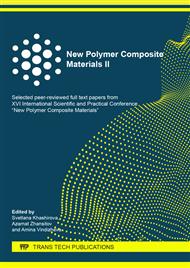[1]
V.G. Zaikin, Mass spectrometry of synthetic polymers, VMSO, Moskow, (2009).
Google Scholar
[2]
F. Lox, Packaging and ecology: a training manual, Publishing house of MGUP, Moskow, (1999).
Google Scholar
[3]
Encyclopedia polymerov, v dvuh tomah. V.A. Kabanov (Ch. Ed.) Publishing House Soviet Encyclopedia, Moskow, (1974).
Google Scholar
[4]
R.N. Gadelshin., P.V. Ponomarev, A.R. Kurbangaleeva, Y.N. Khakimullin, S.I. Volfson, Effect of organoclay on the properties of vulcanized siloxane rubber of the brand SKTFV-803, Key Engineering Materials. 816 (2019) 114-118.
DOI: 10.4028/www.scientific.net/kem.816.114
Google Scholar
[5]
Y.N. Khakimullin, N.N. Simonova, S.V. Guzhova, L.Yu. Zakirova, N.K. Romanova, R.S. Yarullin, Studies of the Effect of Decontamination Methods on the Surface Condition of the Stoppers in Contact with Drugs, Key Engineering Materials. 816 (2019) 260-265.
DOI: 10.4028/www.scientific.net/kem.816.260
Google Scholar
[6]
N.I. Shumskaya, V.N. Provorov, L.V. Emelyanova, Gigienicheskaya ozenka rezinovyh izdelii i ishodnogo syiriya dlya ih izgotovleniya, TsNIITEIneftekhim, Moskow, (1981).
Google Scholar
[7]
A.I. Tentsova, M.T. Alyushin, Polymeri v farmazii in Pharmacy, Medicine, Moskow, (1985).
Google Scholar
[8]
W. Dierick, K. Nakamura, Ready-to-use prefillable syringes: Sterilisation effects on biopharmaceuticals, ONdrug Delivery. 71 (2016) 50-54.
Google Scholar
[9]
D.R. Jenke, Linkingextractables and leachables in container/closure applications/PDA, Journal of Pharmaceutical Science and Technology. 59 (2005) 265-281.
Google Scholar
[10]
N.S. Jones, et al, Silicone oil induced aggregation of proteins, J. Pharm. Sci. 94, (2005) 918-927.
Google Scholar
[11]
K. Nakamura, et al, A strategy for the prevention of protein oxidation by drug product in polymer-based syringes, PDA J. Pharm. Sci. Technol. 69 (2015) 88-95.
Google Scholar
[12]
D. Jenke, et al, Extractable/Leachable Substances from Plastic Materials Used as Pharmaceutical Product Containers/Devices, PDA J. Pharm. Sci. Technol. 56 (2002) 332-371.
Google Scholar
[13]
R.P. Snell, Gas chromatographic determination of cyclohexanone leached from hemodialysis tubing, Journal of AOAC International. 76 (1993) 1127-1132.
DOI: 10.1093/jaoac/76.5.1127
Google Scholar
[14]
H. Kiminami, et al, Low Leachable Container System Consisting of a Polymer-Based Syringe with Chlorinated Isoprene Isobutene Rubber Plunger Stopper, PDA J. Pharm. Sci. Technol. 69 (2015) 713-724.
DOI: 10.5731/pdajpst.2015.01080
Google Scholar
[15]
C. Richter, C. Lipperheide, U. Lipke, A. Lamprecht, Impact of extractables from rubber closures on protein stability under heat stress, European Journal of Pharmaceutics and Biopharmaceutics. 130 (2018) 22-29.
DOI: 10.1016/j.ejpb.2018.06.009
Google Scholar
[16]
T.J. Cardwell, D.J. Desarro, P.C. Uden, Gas chromatography of some volatile metal diethyldithiocarbamates, Anal. chim. Acta. 85 (1976) 542-545.
DOI: 10.1016/s0003-2670(01)84710-3
Google Scholar
[17]
M.L. Riekkola, O. Makitie, M. Sunberg, Analysis of metals as complexes by gas chromatography. Volatile metal chelates of substituted dithiocarbamic acids, Kemia-Kemi, 6 (1979) 525-529.
Google Scholar
[18]
V. Gemmer-Colos, R. Neeb, Fliuchtigkeit und thermische Stabilitateiniger Nickel, –Dithiolatochelateim Hinbliok auf die gas-chromatographischt Bestimmung, Fresenius Z. Anal. Chem., Bd. 311 (1982) 496-408.
DOI: 10.1007/bf00521173
Google Scholar
[19]
R. Silverstein, F. Webster, D. Kiml, Spectrometricheskaya identificaziya organicheskih coedinenii, Binom. Laboratory of Knowledge, Moskow, (2012).
Google Scholar
[20]
A.T. Lebedev, Mass spectrometriya v organicheskoi chimii: a training manual, Binom. Laboratory of Knowledge, Moskow, (2003).
Google Scholar
[21]
GOST 8.315-97 State system for enshuring the uniformity of measurements. Certified reference materials of composition and properties of substances and materials. Basic principles.
Google Scholar


